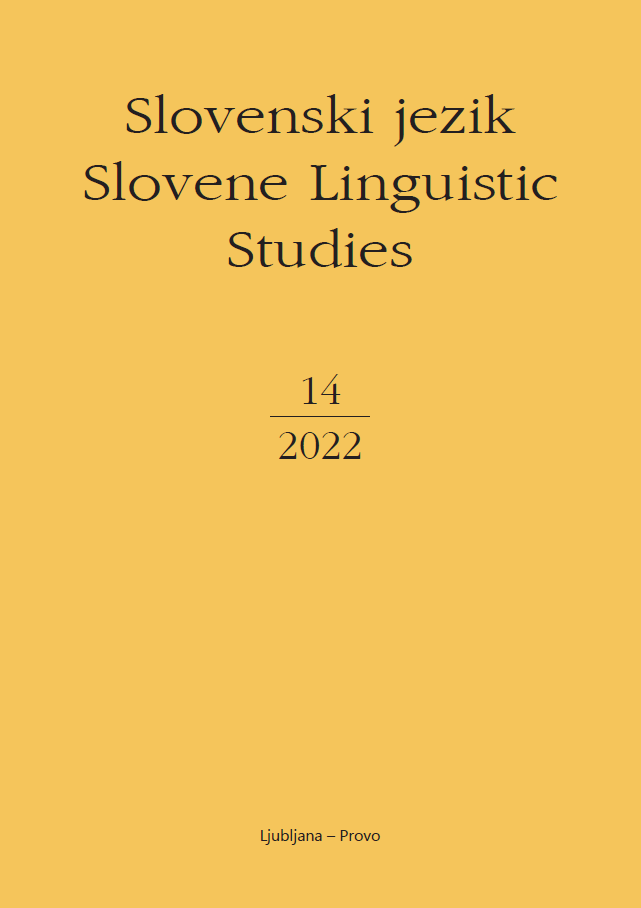Phoneme Frequencies in Slovene (Text vs. Dictionary)
DOI:
https://doi.org/10.3986/sjsls.14.1.03Keywords:
Slovene, phoneme frequencies, repetition rate, frequency of vowels and consonants, statistical significanceAbstract
In this paper Slovene phoneme frequencies from a Slovene–German learner’s dictionary are analysed. The structure of the dictionary allows the determination of phoneme frequencies on two distinct linguistic levels: the level of dictionary (analysis of headwords) and the level of text (example sentences, illustrating a prototypical context of a given headword). By applying various statistical significance tests it can be shown that no significant differences between the rank-frequency distributions are observable. The same holds true for testing the differences, based on the repetition rate of phoneme frequencies on the dictionary and text levels. In contrast to this, only dichotomised data (by grouping them into vowels and consonants) show a significantly different frequency behaviour. Overall it can be shown that based on the given empirical observations, the conceptual importance and relevance of the levels of dictionary vs. text for quantitative phoneme studies has to be reconsidered and critically reflected in future studies.
Downloads
References
Altmann, Gabriel. 1980. Prolegomena to Menzerath’s law. In: R. Grotjahn (ed.): Glottometrika 2. Bochum: Brockmeyer. 1–10.
Altmann, Gabriel. Lehfeldt, Werner. 1980. Einführung in die quantitative Phonologie. Bochum: Brockmeyer.
Chitoran, Ioana. Cohn, Abigail C. 2009. Complexity in phonetics and phonology: gradience, categoriality, and naturalness. In: F. Pellegrino, E. Marsico, I. Chitoran and Ch. Coupé (eds.): Approaches to Phonological Complexity. Berlin: Mouton De Gruyter. 21–46.
Coloma, Germán. 2015. The Menzerath-Altmann Law in a Cross-Linguistic Context. Sky Journal of Linguistics 28: 139–159.
Grzybek, Peter. Kelih, Emmerich. 2005. Häufigkeiten von Buchstaben/Graphemen/Phonemen: Konvergenzen des Rangierungsverhaltens. Glottometrics 9: 62–74.
Hajnšek-Holz, Milena. Jakopin, Primož. 1996. Odzadnji Slovar Slovenskega Jezika po Slovarju Slovenskega Knjižnega Jezika. Ljubljana: ZRC. SAZU.
Herrity, Peter. 2010. Slovene. A comprehensive grammar. London: Routledge.
Janda, Laura A. 2013. Quantitative methods in Cognitive Linguistics: An introduction. In: L. A. Janda (ed.): Cognitive linguistics. The quantitative turn. The essential reader. Berlin: de Gruyter Mouton. 1–32.
Kelih, Emmerich 2018. Phonemfrequenz. In: R. Köhler, S. Naumann and P. Grzybek (eds.): Quantitative und Formale Linguistik. Berlin.: de Gruyter. DOI: https://doi.org/10.1515/wsk.9.0.phonemfrequenz
Kelih, Emmerich. 2016. Phonologische Diversität – Wechselbeziehungen zwischen Phonologie. Morphologie und Syntax. Frankfurt am Main: Lang.
Kelih, Emmerich. 2012. Systematic interrelations between grapheme frequencies and word length: Empirical evidence from Slovene. Journal of Quantitative Linguistics, 19, 3, 205–231.
Kelih, Emmerich 2008. The phoneme-grapheme relationship in Slovene. In: G. Altmann and F. Fengxiang (eds.): Analyses of Script. Properties of Characters and Writing Systems. Berlin. New York: Mouton De Gruyter. 61–74.
Kelih, Emmerich. Vučajnk, Tatjana. 2018. Slovensko-nemški tematski slovar: osnovno in razširjeno besedišče 4500 gesel. frazemov in stavčnih primerov. Grund- und Aufbauwortschatz Slowenisch-Deutsch. 4500 Lemmata. Phrasen und Satzbeispiele. Klagenfurt/Celovec, Wien/Dunaj: Hermagoras/Mohorjeva.
Köhler, Reinhard. 2005. Synergetic linguistics. In: R. Köhler, G. Altmann and R.G. Piotrowski (eds.): Quantitative Linguistik. Quantitative Linguistics. Ein internationales Handbuch. An International Handbook. Berlin, New York: de Gruyter. 760–774.
Kolter, Franz. 1994. Kvantitativna fonološkoa analiza slovenščine. Kosmačev roman Pomladni dan. Klagenfurt: Diploma thesis.
Mačutek, Ján. Kelih, Emmerich. 2022. Free or not so free? On stress position in Russian, Slovene, and Ukrainian. (in press, Proceedings of Qualico. Tokyo 2021).
Mitchell, David. 2019. Models of Lithuanian Grapheme Frequencies. Journal of Quantitative Linguistics, 26, 2. 172–185.
Popescu, Ioan-Iovitz. Altmann, Gabriel. Köhler, Reinhard. 2010. Zipf´s law—another view. Quality and Quantity 44, 4. 713–731.
Pustet, Regina. 2004. Zipf and his heirs. Language Sciences 26, 1. 1-25.
Rehder, Peter. 2006. Das Slovenische. In: P. Rehder (ed.): Einführung in die slavischen Sprachen. (mit einer Einführung in die Balkanphilologie). 5. Auflage. Darmstadt: Wissenschaftliche Buchgesellschaft. 230–245.
Skalička, Vladimír. 1966. Konsonatenkombinationen und linguistische Typologie. Travaux Linguistiques de Prague 1: 111–114.
Srebot-Rejec, Tatjana. 1988. Word acent and vowel duration in standard Slovene. An acoustic and linguistics investigation. München: Sagner.
Tivadar, Hotimir 2004. Fonetično-fonološke lastnosti samoglasnikov v sodobnem književnem jeziku. Slavistična revija 52, 1, 31–48.
Toporišič, Jože 2000. Slovenska slovnica. Maribor: Obzorja.
Trubetzkoy, N.S. 1939. Grundzüge der Phonologie. Göttingen: Vandenhoeck & Ruprecht ( = Travaux du Cercle Linguistique de Prague, 7). (citation based on 7th edition, 1989)
Wilson, Andrew. Mačutek, Ján. 2020. A Classification of the Celtic Languages Based on Grapheme Frequencies. In: Emmerich Kelih and Reinhard Köhler (eds.): Words and Numbers. In Memory of Peter Grzybek (1957-2019). Lüdenscheid: Ram-Verlag. 53–68.
Zöfel, Peter. 2002. Statistik verstehen. Ein Begleitbuch zur computergestützten Anwendung. München u.a.: Addison-Wesley.
Zörnig, Peter. Altmann, Gabriel. 1983. The Repeat Rate of Phoneme Frequencies and the Zipf-Mandelbrot Law. Glottometrika 5: 205-211.
Downloads
Published
Versions
- 2023-03-27 (2)
- 2022-12-07 (1)
How to Cite
Issue
Section
License

This work is licensed under a Creative Commons Attribution-NonCommercial-NoDerivatives 4.0 International License.
Authors guarantee that the work is their own original creation and does not infringe any statutory or common-law copyright or any proprietary right of any third party. In case of claims by third parties, authors commit their self to defend the interests of the publisher, and shall cover any potential costs.
More in: Submission chapter





